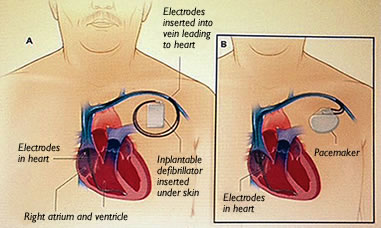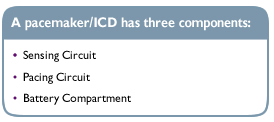|
Pacemaker-Defibrillator and Your Non-Cardiac SurgeryAbd Khatib, MD To understand how a pacemaker works, it is helpful to review how electricity is used by the heart to make it beat. The heart is a muscle that pumps blood to all parts of our body when it beats. In order for the heart to beat, it needs electricity that your body produces naturally. When this electricity travels across the heart muscle, it causes the heart to contract, or beat. A problem with any part of this electrical system can cause an irregular heartbeat, or arrhythmia. An arrhythmia is when the heart beats too fast, too slow or irregularly. Most irregular heartbeats are harmless, but some can be serious.
Comparison of an Implantable Cardioverter-Defibrillator and a Pacemaker
Non-cardiac surgery can also affect a pacemaker or ICD. Certain parts of non-cardiac surgery can interfere with your pacemaker or ICD. Electrocautery is a technique used to decrease or stop bleeding during surgery. The currents produced by electrocautery can reprogram the pacemaker and change the way it works, or even turn the pacemaker off. It is important to remind your surgeon that you have a pacemaker or ICD before surgery. It is equally important to let your cardiologist know of any scheduled surgeries to prevent any interference with pacemaker function during your surgery. In the event of non-cardiac surgery, reprogramming or magnet application to the pacemaker/defibrillator is necessary. For additional information, we encourage you to talk to your doctor.
Dr. Khatib – Eau Claire Heart Institute |



 There are different types of implantable devices to treat irregular heartbeats. A pacemaker is a small unit that works by producing a small electrical stimulation to help the heart beat normally. An Implantable Cardioverter-Defibrillator (ICD) is also a small device that is placed in the chest or abdomen to monitor your heartbeat and help control irregular heartbeats. An ICD uses electrical pulses or shocks to regulate life-threatening arrhythmias, especially those that can cause sudden cardiac death. Pacemakers give low energy electrical pulses, while ICDs produce low and high energy electrical pulses. People with a weak heart muscle may need a special pacemaker called a Cardiac Resynchronization Therapy (CRT) device. Your cardiologist can discuss these options with you and determine the best device for an irregular heartbeat.
There are different types of implantable devices to treat irregular heartbeats. A pacemaker is a small unit that works by producing a small electrical stimulation to help the heart beat normally. An Implantable Cardioverter-Defibrillator (ICD) is also a small device that is placed in the chest or abdomen to monitor your heartbeat and help control irregular heartbeats. An ICD uses electrical pulses or shocks to regulate life-threatening arrhythmias, especially those that can cause sudden cardiac death. Pacemakers give low energy electrical pulses, while ICDs produce low and high energy electrical pulses. People with a weak heart muscle may need a special pacemaker called a Cardiac Resynchronization Therapy (CRT) device. Your cardiologist can discuss these options with you and determine the best device for an irregular heartbeat. 
 In most pacemakers, a magnet can be applied to the device to
adjust the sensing and pacing circuits or to turn them on and off. Because magnets can change the programming of a pacemaker,
it is important to avoid or stay away from strong magnetic fields such as MRI scanners or airport metal detectors, if you have a pacemaker or ICD.
In most pacemakers, a magnet can be applied to the device to
adjust the sensing and pacing circuits or to turn them on and off. Because magnets can change the programming of a pacemaker,
it is important to avoid or stay away from strong magnetic fields such as MRI scanners or airport metal detectors, if you have a pacemaker or ICD.